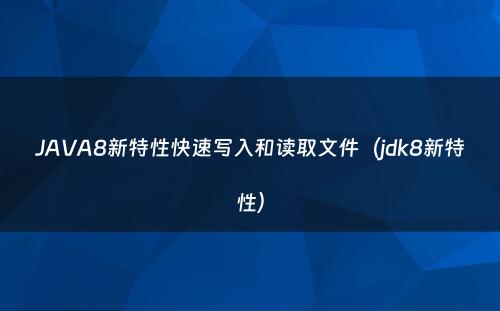网站首页 > java教程 正文
话不多说,先看题:

随机生成 Salary {name, baseSalary, bonus }的记录,如“wxxx,10,1”,每行一条记录,总共1000万记录,写入文本文件(UFT-8编码), 然后读取文件,name的前两个字符相同的,其年薪累加,比如wx,100万,3个人,最后做排序和分组,输出年薪总额最高的10组:
name 4位a-z随机,baseSalary [0,100]随机 bonus[0-5]随机 ,年薪总额 = baseSalary*13 + bonus。
思路:
第一步:先编写一个Salary对象
里面包含有name,baseSalary, bounus属性,然后编写一个构造器,重写toString()方法方便序列化数据,同时编写构建Salary对象的方法build();
/**
* name 4位a-z随机
* baseSalary 0-100随机
* bonus 0-5随机
* 年薪总额 = baseSalary * 13 + bonus
*/
class Salary {
// name 4位a-z随机,baseSalary 0-100随机,bonus 0-5随机 年薪总额 = baseSalary * 13 + bonus
private String name;
private int baseSalary;
private int bonus;
public String getName() {
return name;
}
public void setName(String name) {
this.name = name;
}
public int getBaseSalary() {
return baseSalary;
}
public void setBaseSalary(int baseSalary) {
this.baseSalary = baseSalary;
}
public int getBonus() {
return bonus;
}
public void setBonus(int bonus) {
this.bonus = bonus;
}
public Salary() {
}
public Salary(String name, int baseSalary, int bonus) {
this.name = name;
this.baseSalary = baseSalary;
this.bonus = bonus;
}
public Salary build() {
this.name = getRandomName(4);
// 0-100随机数
this.baseSalary = (int)(100 * Math.random());
// 0-5随机数
this.bonus = (int)(5 * Math.random());
return this;
}
@Override
public String toString() {
return name + " " + baseSalary + " " + bonus;
}
/**
* 生产Name随机函数 4位a-z随机
* @param length
* @return
*/
private static String getRandomName(int length ){
String base = "abcdefghijklmnopqrstuvwxyz";
Random random = new Random();
StringBuffer sb = new StringBuffer();
for ( int i = 0; i < length; i++ ){
int number = random.nextInt(base.length());
sb.append(base.charAt(number));
}
return sb.toString();
}
}
第二步:编写写入方法
a) 第一种方式,使用Java的IO中BufferedWriter写入文件
/**
* 写入文件
* @return
* @throws IOException
*/
public static File writeBuffer() throws IOException {
File file = new File(FILE_NAME);
FileOutputStream fos = new FileOutputStream(file);
BufferedWriter writer = new BufferedWriter(new OutputStreamWriter(fos));
int i = AMOUNT;
while(i > 0) {
Salary salary = new Salary().build();
writer.write(salary.toString() + "\r\n");
i --;
}
writer.close();
fos.close();
return file;
}
b) 第二种方式,使用JAVA的NIO中的FileChannel进行写入
/**
* NIO进行写入
* @throws IOException
*/
private static void writeNIO() throws IOException {
FileOutputStream fos = new FileOutputStream(FILE_NAME, true);
FileChannel channel = fos.getChannel();
int i = AMOUNT;
StringBuffer content = new StringBuffer();
while(i > 0) {
Salary salary = new Salary().build();
content.append(salary.toString()).append("\r\n");
i --;
}
ByteBuffer buf = ByteBuffer.wrap(content.toString().getBytes());
buf.put(content.toString().getBytes());
buf.flip();
channel.write(buf);
channel.close();
fos.close();
}
比较下来,单纯从这个代码的性能上讲差不太多!
第三步:读取并解析文件在进行排序
a) 通过JAVA的IO进行读取:
/**
* Java IO读取文件的方式
* @return
* @throws Exception
*/
public static List<Salary> readFileIO() throws Exception {
File file = new File(FILE_NAME);
List<Salary> list = new ArrayList<>();
InputStreamReader reader = new InputStreamReader(new FileInputStream(file)); // 建立一个输入流对象reader
BufferedReader br = new BufferedReader(reader); // 建立一个对象,它把文件内容转成计算机能读懂的语言
String line = ""; // 每一行的内容
int i = 1;
while ((line = br.readLine()) != null) {
String[] split = line.trim().split(" ");// .trim()可以去掉首尾多余的空格
list.add(new Salary(split[0], Integer.valueOf(split[1]), Integer.valueOf(split[2]))); // 添加一个Salary实体
i++;
}
reader.close();
br.close();
return list;
}
b) 通过JAVA的NIO读取:
/**
* JDK8 NIO读取文件
* @return
* @throws Exception
*/
public static List<Salary> readFileNIO() throws Exception {
List<Salary> list = new ArrayList<>();
Files.lines(Paths.get(FILE_NAME)).forEach(line -> {
String[] split = line.trim().split(" ");// .trim()可以去掉首尾多余的空格
list.add(new Salary(split[0], Integer.valueOf(split[1]), Integer.valueOf(split[2]))); // 添加一个Salary实体
});
return list;
}
二者比较下来:使用jdk1.8读取更简单,效率性能更高!
第四步:使用JDK8的Stream进行排序和截取
/**
* 排序并获取前十数据
* @param salaries
*/
public static void sort(List<Salary> salaries) {
Map<String, GroupSalary> result = new HashMap<>();
salaries.forEach(salary -> {
String shortName = salary.getName().substring(0, 2);
GroupSalary groupSalary = null;
List<Salary> salaryList = null;
if (result.containsKey(shortName)) {
groupSalary = result.get(shortName);
salaryList = groupSalary.getSalaries();
} else {
groupSalary = new GroupSalary();
salaryList = new ArrayList<>();
groupSalary.setSalaries(salaryList);
}
salaryList.add(salary);
groupSalary.setShortName(shortName);
groupSalary.setTotal(groupSalary.getTotal() + salary.getBaseSalary() * 13 + salary.getBonus());
result.put(shortName, groupSalary);
});
List<GroupSalary> r = result.entrySet().stream()
.sorted((Map.Entry<String, GroupSalary> o1, Map.Entry<String, GroupSalary> o2) -> o2.getValue().getTotal() - o1.getValue().getTotal())
.map(entry -> entry.getValue()).collect(Collectors.toList()).subList(0,10);
r.forEach(groupSalary -> {
System.out.println(groupSalary.getShortName() + " " + groupSalary.getTotal() + " " + groupSalary.getSalaries().size());
});
}
同时将数据封装在GroupSalary中
class GroupSalary {
private List<Salary> salaries;
private String shortName;
private int total;
public List<Salary> getSalaries() {
return salaries;
}
public void setSalaries(List<Salary> salaries) {
this.salaries = salaries;
}
public String getShortName() {
return shortName;
}
public void setShortName(String shortName) {
this.shortName = shortName;
}
public int getTotal() {
return total;
}
public void setTotal(int total) {
this.total = total;
}
}
到此如果写入100W数据基本上1分钟不到就可以完成写入和读取,欢迎大家进行改写和优化。
猜你喜欢
- 2024-10-01 「每日分享」内存文件映射方式读取超大文件踩坑题解析
- 2024-10-01 尚学堂百战程序员之读写配置文件教程
- 2024-10-01 Spark中读写不同类型文件(如何改文件的读写类型)
- 2024-10-01 Java中文件使用流操作基础知识(java文件流不关闭的后果)
- 2024-10-01 Java 读取txt文件生成Word文档(java读取txt文件存为字符串)
- 2024-10-01 零基础编程培训系列JAVA入门课程第十一讲Java文件处理
- 2024-10-01 SpringBoot读取.yml配置文件最常见的两种方式
- 2024-10-01 java IO流读取文件并统计文件中各个字符出现的次数
- 2024-10-01 Java读取配置文件config.properties
- 2024-10-01 常见Java问题及笔试题(十八)——说一说代码中读取文件的事
欢迎 你 发表评论:
- 12-16qq加密空间查看器在线(q讯看加密空间)
- 12-16剪切板在哪打开(剪切板内容怎么调出)
- 12-16dell笔记本进入安全模式(dell笔记本安全模式按f5还是f8)
- 12-16电脑怎么装虚拟机(电脑怎么装虚拟机软件)
- 12-16lenovo联想打印机驱动官方网站
- 12-16微软必应官网(微软必应软件下载)
- 12-16win10输入法图标不见了怎么办
- 12-16oppo手机重新设置密码(oppo手机如何重新设置密码)
- 最近发表
- 标签列表
-
- java反编译工具 (77)
- java反射 (57)
- java接口 (61)
- java随机数 (63)
- java7下载 (59)
- java数据结构 (61)
- java 三目运算符 (65)
- java对象转map (63)
- Java继承 (69)
- java字符串替换 (60)
- 快速排序java (59)
- java并发编程 (58)
- java api文档 (60)
- centos安装java (57)
- java调用webservice接口 (61)
- java深拷贝 (61)
- 工厂模式java (59)
- java代理模式 (59)
- java.lang (57)
- java连接mysql数据库 (67)
- java重载 (68)
- java 循环语句 (66)
- java反序列化 (58)
- java时间函数 (60)
- java是值传递还是引用传递 (62)

本文暂时没有评论,来添加一个吧(●'◡'●)